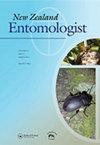A re-examination of doubtful New Zealand tick records: lost species, misidentifications or contamination?
IF 0.4
4区 农林科学
Q4 ENTOMOLOGY
引用次数: 1
Abstract
ABSTRACT In the early twentieth century, three species of ticks – Haemaphysalis leachii, Hyalomma aegyptium and Ixodes ricinus – were originally thought to be part of the New Zealand fauna. In the absence of any firm evidence for their continued existence in this country, and without any satisfactory explanation for their original appearance, they were deleted from faunal lists about 60 years later. After consulting all relevant literature, we have dismissed the original suggestion that both the ticks Ha. leachii and Hy. aegyptium – originally taken from a museum specimen of the extinct huia, Heteralocha acutirostris – were introduced along with the Indian myna, Acridotheres tristis. Instead we find that there was a greater chance that their presence was the result of contamination, possibly through the collecting efforts and extensive travel of Walter L. Buller, a nineteenth-century naturalist and ornithologist. Further, although Hy. aegyptium was correctly identified, the other huia tick is actually Haemaphysalis (Rhipistoma) indica, not Ha. leachii sensu stricto. The taxonomic history of Ha. leachii (but not the other two species) has been convoluted and the spelling of the species epithet has frequently been contradictory. We briefly examine this history and clarify the correct spelling of that species name. We conclude that the supposed presence of I. ricinus was due to misidentification, possibly being confused with the cattle tick, Haemaphysalis longicornis, or the kiwi tick, Ixodes anatis.重新检查可疑的新西兰蜱虫记录:物种丢失,错误识别还是污染?
在20世纪初,三种蜱——淋血蜱、埃及透明蜱和蓖麻蜱——最初被认为是新西兰动物群的一部分。由于没有任何确凿的证据证明它们在这个国家继续存在,而且对它们最初的样子也没有任何令人满意的解释,大约60年后,它们从动物名单上被删除了。在查阅了所有相关文献后,我们已经驳回了原来的建议,即两个蜱哈。leachii和hys . aegyptium——最初是从一个已经灭绝的huia, Heteralocha acutirostris的博物馆标本中提取出来的——与印度八哥,acrido有tristis一起被引入。相反,我们发现它们的存在更有可能是污染的结果,可能是19世纪博物学家和鸟类学家沃尔特·l·布勒(Walter L. Buller)的收集工作和广泛旅行造成的。此外,虽然埃及伊蜱被正确地鉴定出来,但另一种蜱实际上是印度血蜱,而不是哈蜱。Leachii sense u stricto。Ha.的分类历史。Leachii(但不是其他两个物种)一直很复杂,物种绰号的拼写经常是矛盾的。我们简要地检查这段历史,并澄清该物种名称的正确拼写。我们的结论是,假定的蓖麻蜱的存在是由于误认,可能与牛蜱、长角血蜱或猕猴桃蜱混淆。
本文章由计算机程序翻译,如有差异,请以英文原文为准。
求助全文
约1分钟内获得全文
求助全文
来源期刊

New Zealand Entomologist
ENTOMOLOGY-
CiteScore
0.70
自引率
33.30%
发文量
3
审稿时长
>12 weeks
期刊介绍:
The invertebrate diversity of New Zealand is of great interest worldwide because of its geographic isolation and geological history. The New Zealand Entomologist plays an important role in disseminating information on field-based, experimental, and theoretical research.
The New Zealand Entomologist publishes original research papers, review papers and short communications. We welcome submissions in all aspects of science regarding insects and arthropods in a New Zealand or Australasian setting. The journal’s subject matter encompasses taxonomy, phylogenetics, biogeography, biological control and pest management, conservation, ecology and natural history.
The journal is the official publication of the Entomological Society of New Zealand. Papers published or submitted elsewhere for publication will not be considered, but publication of an abstract or summary elsewhere (e.g. conference proceedings) does not preclude full publication in the New Zealand Entomologist. Accepted papers become copyright of the Entomological Society of New Zealand. The journal is published in English, but we also welcome publication of abstracts in Maori.
 求助内容:
求助内容: 应助结果提醒方式:
应助结果提醒方式:


